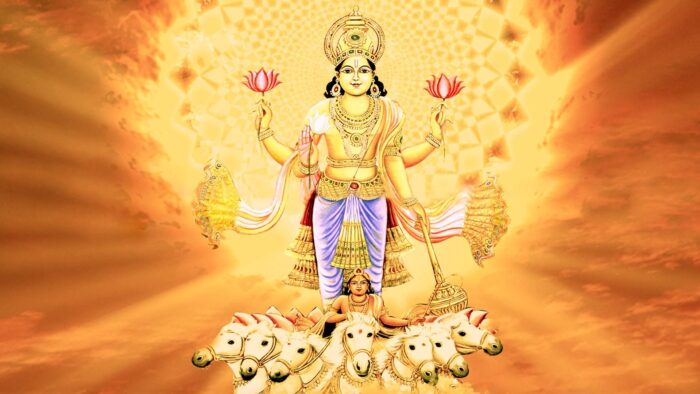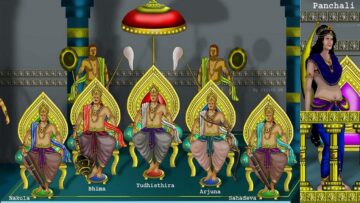The Samskŗt word Samkrānti means transference, transit, migration, shifting, etc. Makara Samkrānti is the transit of the Sun from the Dhanu Rāṡi (Zodiac: Sagittarius) to the Makara Rāṡi (Zodiac: Capricorn). This year Makara Samkrānti is celebrated on 14th January.
This is of great significance to the Dhārmic tradition because it is considered traditionally as the start of Uttarāyana (the northward motion of the sun).
The northward motion of the sun is very holy in our Dhārmic tradition. In the Mahābhārata, Bhīṣma Pitāmaha is mentioned as waiting for the commencement of Uttarāyana to die because it was auspicious to die during Uttarāyana, especially on the day of the start of Uttarāyana.
It is also significant in other ways. In most of the ancient polytheist traditions that predates the rise of Abrahamic monotheism, Uttarāyana day also is considered as the start of a New Year!
In the sky of the Earth, the sun has three types of apparent motions, each of them a reflection of the Earth’s own three types of motions:
The first motion is the daily motion of the sun in 24 hours in the sky of the Earth due to the Earth’s rotation on its own axis, rising in the east and setting in the west. Thus, the sun gives us one day and night.
The second motion is the annual motion of the sun in the sky of the Earth due to the Earth’s orbit around the sun as a planet. In this motion, the sun shifts slowly across the twelve divisions in the sky called Zodiac or Rāṡi in the order of Meṣa, Ŗṣabha, Mithuna, Karkataka, Simha, Kanya, Tula, Vŗṡcika, Dhanu, Makara, Kumbha and Meena in a west to east direction.
The Sun stays in each Rāṡi for one month and one full circle is completed in one year. In other words, this motion of the sun is what we interpret as one solar year. During this motion, the sun additionally has a north to south pendular motion.
This is due to the 23.5-degree tilt in the axis of the Earth’s rotation. Due to this, the Sun appears positioned slightly to the south or north to an observer of Earth, when the Earth is at various positions in the orbit.
The Sun’s position reaches its southern point at the Winter Solstice (WS). Currently, this occurs on 21st December. On this day, we experience the shortest day and the longest night. After this, the Sun moves northwards. This is called Uttarāyana.
In other words, the commencement of Uttarāyana currently occurs on 21st December. As the Sun moves northwards, the days get longer and longer until we experience the equal duration of day and night at Vernal Equinox (VE). This currently occurs around 20th March.
The Sun continues moving northwards until we reach a day called the Summer Solstice (SS) where we get the longest day and the shortest night. This currently occurs on 21st June. After this, the Sun moves southwards. This is called Dakṡināyana.
As the Sun moves southwards, the days get shorter and shorter until we experience an equal duration of day and night at the Autumnal Equinox (AE). Currently, this occurs on the 23rd of September. The Sun continues moving southwards until it reaches back at the Winter Solstice (21st December).
These four events in the Sun’s motion: WS, VE, SS, and AE were described as ‘the four corners of the sky’ in the ancient astronomy traditions such as among the Mayans and among the Bhāratīya traditions.
These four events, the related movement of the Sun into northern and southern extremities in its path in the terrestrial sky, the resultant shortening of the days or nights, and the resultant reduction in the heat and light of the Sun as experienced on the surface of the Earth, give rise to the phenomenon called the ‘seasons’.
Around WS, we experience Winter and around SS, we experience Summer. Around VE, we experience the Spring Season and around AE, we experience the Autumn season. Bhāratīyas recon six seasons instead of the above four as Ṡiṡira (winter), Vasanta (spring), Grīṣma (summer), Varṣa (rains), Ṡarad (autumn) and Hemanta (pre-winter).
Anybody who understands the above will immediately recognize that there is something wrong in the celebration of Uttarāyana on the day of Makara Samkrānti on 14th January. We are not celebrating Uttarāyana at the actual start of Uttarāyana at 21st December, viz the Winter Solstice Day. There is an offset of around 24 days from 21st December to 14th January. How it came about?
In order to know this, we need to understand the third motion of the Sun, which is very difficult to notice because it takes around 25,920 years to fully notice this revolutionary motion of the Sun in the terrestrial sky! This motion is the result of the slow precession of the Earth’s rotation axis. The direction vector of Earth’s rotation axis is not remaining static.
This axis wobbles or turns itself making a full circle, which the scientists currently estimate to 25772 years.

The discovery of precession, observed as the slow shifting of the equinox date in the calendar, as centuries pass by, is generally attributed to the Greek scholar Hipparchus (190 – 120 BCE). The phenomenon is called ‘the precision of the equinox’. As per this author’s analysis, this knowledge existed in most of the ancient sedentary civilizations with 3000 or more years of naked sky observation capability, such as the Bhāratīya civilization.
The oldest Harappan/IVC/SSC settlements of Bhārata are now found at Bhirrana (8th and 7th millennium BCE) along the Ŗgvedic Sarasvatī River. It was continuously occupied from 7500 BCE to 2600 BCE. The settlements of Rakhigarhi, not far away and lying on the banks of the Ŗgvedic Dŗṡadvatī River was continuously occupied from 6500 BCE to 1900 BCE.
These two settlements fall close to a region mentioned in our ancient texts as famous for its astronomy observation, viz. the plains of Kurukṣetra. As per the Mahābhārata, Kurukṣetra is a place where people gather for observing the movements of the Sun, moon, and planets and note down lunar and solar eclipses.
Vyāsa, Kŗṣṇa, Karṇa, Bhīṣma, and others were mentioned as keen observers of astronomical phenomena. Several eclipses are recorded in the Mahābhārata and events where the Yādavas and the Kurus gather in Kurukṣetra for observing the Sun too is mentioned.
The oldest text of Bhāratīya civilization, viz. the Ŗgveda mentions about the division of the sky into 12, 360 and 720 parts using a concept called the Kālacakra. The 12 divisions of Kālacakra help to recon the 12 months. The 360 divisions help to recon the number of days in a traditional solar year which contained 360 days instead of 365.25 days.
The residue or the remaining 5.25 days of a year is technically termed as a ‘Vatsa’ (calf) and the year is called a ‘Vatsara’ (meaning ‘the one possessing a calf’) i.e., a cow. The Sun is conceived as a dial of this Kālacakra (the sky-clock) using which the flow of time can be calculated. It is mentioned as having three gears (modes of operation) corresponding to its three motions, viz. the daily, annual, and precessional motions of the Sun.
The number 72 is cryptically encoded into this conception by stating that 720 sons in pairs resided in the Kālacakra. If we multiply 72 with 360, we get 25772 which is the traditionally encoded duration of the precision of the equinoxes.
This is the reason why this important number 72 is preserved even in other traditions influenced by Bhārata, such as the 72 threads in the Zoroastrian Kusti and the 72 virgins in the Arabian heaven. The actual multiplier number is 71.5, which is approximated as 71 or 72.
Hence our Purāṇic tradition remembers it as 71, like how a Manvantara is conceived as 71 Catur-Yugas.
In 72 years, the equinox position shifts by 1 degree in the sky. This is approximately equivalent to a shift in 1 day in the calendar since the 360 degrees of the sky corresponds to the 365.25 days in a year.
Thus after 72 years, the four corners of the sky shift by 1 day in the calendar, and in 720 years they will shift by 10 days. In other words, the Winter Solstice which occurs today on 21st December will shift to 11th December 720 years from now in around 2740 CE, in our future.
When the same calculation is done backwards into the past, the Winter Solstice and Uttarāyana coinciding with the Makara Samkrānti (14th January) that occurred around 17 centuries ago (approximately in 2nd to 3rd Century CE) even after compensating for other calendrical errors.
This is approximately the time when our current tradition of celebrating Uttarāyana on the day of Makara Samkrānti originated.
The tradition of celebrating Makara Samkrānti as the start of Uttarāyana is thus the result of a kind of ‘freeze’ in our traditions, as we stopped updating our festival calendars by making it shift freely along with the precession of the equinox and the slow shift of seasons.
Are there any side effects for this freeze?
Primarily, this will make our tradition at variance with science. Contrary to popular belief, our Dhārmic tradition is not anti-science and it always went along with science and with truth (Satya/Ŗta).
Hence, we have no reason to be at variance with science or astronomy and make our children question us:- Why we are celebrating Uttarāyana at Makara Samkrānti (14th January) date while the true Uttarāyana happened many days ago at Winter Solstice (21st December)?
Second, all our festivals are related to our seasons. This is how we generate the Dhārmic energy by celebrating each festival at the right seasons in which they are meant to be celebrated. An offset in the celebrating of our festivals with respect to the seasons in which they are meant to be celebrated can cause the slow depletion of the Dhārmic energy.
In the current situation, the offset is only 24 or 25 days, and hence they marginally fall in the seasons that they are meant to fall. But it is always desirable to rectify our festival calendar as we have always done in the past once in every 1000 or 2000 years.
The evidence of discarding the old calendar and creating new calendar is symbolically attested in our Veda, Itihāsa, Purānic narratives. Here are some examples: – Indra is mentioned as breaking the chariot of the goddess Uṣas (implying the motion of the planet Venus) and stealing the wheel of the Sun (implying Kālacakra and time calculations), mentioned in Ŗgveda. Similarly, the change in the designation of the Pole Star from one star to another (like Abhijit and Dhruva) is mentioned in the Mahābhārata.
It shows that our ancient tradition had the knowledge of the change in the direction vector of the Earth’s rotation axis. The change of the Pole Star is associated with other cyclical periods like Manvantara and Catur-Yuga cycles.
The fact that they are conceived as cyclic shows that we additionally knew that the axial-vector not only change but also make complete revolutions. Thus, our tradition had full knowledge of the precession of the equinoxes and the consequent activity of discarding the old calendars and creating new calendars.
Is there anything we can do, if our tradition cannot quickly change the Uttarāyana celebration from Makara Samkrānti date (current: 14th January) to the Winter Solstice date (current: 21st December) since it is a huge cultural change involving many astrologers and traditional stakeholders and the 100 crore common Dhārmic people who celebrate these festivals? Yes.
This author is trying to popularize a festival called Āditya Festival which starts from the Winter Solstice Day (21st December) to the Gregorian New Year Day (1st January) for 12 days. Each of these 12 days is dedicated to one among the 12 Ādityas, the sons of goddess Aditi.
The 1st Day, the Winter Solstice/Uttarāyana Day is dedicated to Āditya Vivasvat or Mārtāṇḍa (our Sun God or Surya Deva). December 25th is celebrated as the day of Āditya Viṣṇu, instead of Christmas Day.
December 25th of 2020 happened to be Vaikunta Ekadaṣi Day and Geeta Jayanti, strengthening this Samkalpa. January 1st is celebrated as the day of Āditya Indra. It is always good to start the New Year in memory of Indra rather than the day of the circumcision of Jesus (viz. the 7th day after his proposed birth on 25th December, based on the Jews custom of circumcision of the new born).
This 12-day festival is not a completely new innovation. Our tradition followed two types of calendars – solar and lunar. The Moon makes one revolution around Earth in approximately 29 days. The Sun stays 30 days in each of the 12 zodiacs. A lunar calendar has 12 x 29 = 348 days. A solar calendar has 12 x 30 = 360 days.
The difference of 12 days between the lunar and solar calendars was traditionally treated as festival days at the end of a lunar year. Such 12-day celebrations, starting with the Winter Solstice, existed in all the Indo-European cultures from Bhārata and Tocharian in the east up to Europe in the west. Some examples are Saturnalia, Juul, Yule and so on celebrated in Italic, Germanic, and Celtic traditions of Europe.

Video Commemorating the Āditya Festival: –https://youtu.be/szdWf7ilmKs
A new 12-day Āditya Festival will align the Bhāratīya traditions with the world-wide polytheist festivals which celebrate the Winter Solstice and Uttarāyana. It will be helpful to forge an alliance of Sanātana Dharma with the pre-existing and re-emerging polytheist traditions of the world to counter the Abrahamic dominance. The original narrative of a divinity who was dead and then resurrected was about the Ŗgvedic god viz. the Āditya Mārtāṇḍā. This was transposed to Zoroastrian Mithra who was worshipped even in Rome.
From there, it was appropriated into Christianity as the death and resurrection of Jesus. The original polytheist cross represented the cross formed by joining the ‘four corners of the sky’ (WS, VE, SS, AE) on the Kālacakra, which was appropriated into Christianity as the Christian cross. By re-energizing the 12-day Āditya Festival, we will in effect return back to Mārtāṇḍā, to Winter Solstice and to Uttarāyana from where it all began, taking it back from the Abrahamism which appropriated this festival and turned it into Christmas and New Year.

Besides, each of the days from 1st January, through 25th December to 21st December were 12 ancient Winter Solstice Days, thus perfect for worshipping each of the 12 Ādityas, like how Mārtāṇḍā (our Sun God) is worthy of worship at 21st December.
In conclusion, by becoming conscious of the fact that Makara Samkrānti is not true Uttarāyana, by recognizing that the true Uttarāyana occurs on 21st December at Winter Solstice, our Dhārmic tradition will become in sync with science and truth (Ŗta) as it always was.
Additionally, by celebrating the 12-day Āditya Festival from 21st December Uttarāyana/Winter Solstice, we can prevent the depletion of the Dhārmic energy that occurs due to the small offset in the festival calendar.
Finally, in the remote future, when we correct all our festivals to make them in sync with the shift in the equinoxes and solstices and hence also in perfect sync with our seasons, our Dharma will usher in a new Ŗta Yuga, in an era of Dharmic Renaissance.
Featured Image Credits: amarujala
Disclaimer: The opinions expressed in this article belong to the author. Indic Today is neither responsible nor liable for the accuracy, completeness, suitability, or validity of any information in the article.










